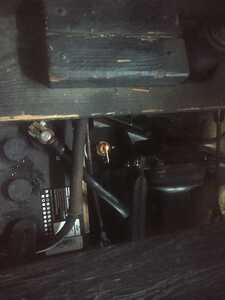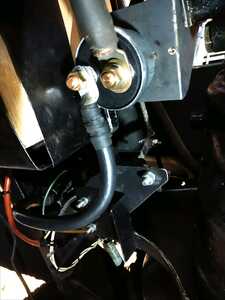Since I don't drive my car on a regular basis, I've always had issues keeping the battery fully charged which has resulted in fully drained batteries over the years. I try to take the car out for a drive once a week and make sure I start it at least once every couple of days.
I recently had the generator rebuilt and had a new voltage regulator installed. It looked like it fixed the issue. I had the car started daily and drove it a couple of times until a couple of days ago I tried to start and discovered the battery was fully drained overnight. I installed the spare battery and it started right up. I should also mention that since the installation of the rebuilt generator and voltage regulator, I've noticed the charging needle jumps off the scale when revving up the engine.
I'm wondering if anyone has had similar issues and what could cause the sudden draining of the battery?
Thanks.
If a battery is over charged regularly it can damage its ability to hold a charge.
On my 41 the charging needle stays in the middle when driving normally. If I have to crank it more than normal then the needle is to the charging side of the gauge for a short bit. Adding a load will cause the needle to temporarily move slightly to the discharge side for a moment and then it goes back to the middle.
Hilton, New York
1941 Chevrolet Master Deluxe
1987 Monte Carlo LS
2001 Chrysler Sebring Convertible
I put a cheap ground disconnect on my vehicles and it stopped all the draining.
I used to have a cheap battery disconnect switch (the one with the green turn knob) on my '28, but recently I found that with the green knob loosened, it WASN'T disconnected!
Evidently, if the cable hanging on to the cheap disconnect is heavy enough, gravity will pull it down and keep it connected. ;-(
I replaced the cheap disconnect with a more substantial disconnect switch from Napa and I mounted it on the side of the transmission, next to the battery box. At car shows, when I disconnect the battery (to keep the horn from blowing when kids hit the button), this switch has a key that I can take with me after turning the juice off. See the attached pics of the top and the bottom of the installed switch.
BTW, I needed a short 2-0 cable to go between the switch and the battery, so I went to a local Interstate Battery store and they made me a custom cable for only $15. 😉
Cheers, Dean
Dean "Rustoholic" Meltz
San Leandro, CA
3511 posts on vccachat.org
Lurch -1927 LM one ton truck - tinyurl.com/Lurch-VCCACHAT-Gallery
Justin - 1928 AB Canopy Express (1/2 ton truck) - tinyurl.com/Justin-Stovebolt-Gallery
Great Information! Many Thanks 🙂
The green knob on the battery terminal type have rarely been a definite disconnect but the key type are a much more definite disconnect with the added security that while the key is in your pocket you are generally the only 1 to drive it away.
Tony
I think the disconnect is just a band aid and does not solve the issue. There is some parasitic drain caused by either a bad connection, or there may be corrosion on the points in the voltage regulator that may be causing the issue. The shop manual mentions cleaning the corrosion from the "points" with a riffler file to get all of the crud out of there. I am facing this issue with my recently resssurected 53 Bel Air. I put a new fully charged battery in and within a day and a half, it was deader than a doornail. I am in the process of clening all of the contacts related to the charging system to see if I can get the parasitic drain issue solved. My othe 53 has the battery connected all of the time and there is no drain on the battery, it sits like that over the winter and never fails to start. Just my 2 cents.
Cheers,
Dave
1953 Two Ten 4 door sedan
1953 Bel Air 2 door Hardtop
1968 Impala SS Convertible
Any chance the glove box light is staying on with the door closed? Disconnect the positive battery cable and connect an ammeter between the battery post and the cable. If there is a parasitic draw there will be a reading. I’d start troubleshooting by removing the bulb in the glove box and rechecking with the door closed. If it’s not the light, disconnect wires one at a time until the ammeter reading goes away. Be sure to check (disconnect) the horn button ground wire coming out of the lower end of the steering column where it connects to the horn relay. I had one that was shorted enough for a parasitic draw but not enough to activate the relay and beep the horns.
So far, I have removed the bulb in the glove box, disconnected the Generator, the regualtor, the cigar lighter, the radio, the blower motor the horn relay. I have checked to make sure there are no bulbs glowing very dimly anywhere else on the car. The only things not disconnected are the solenoid, the dimmer swtich and the ignition switch. Still getting current draw, not sure what could be wrong at this point any ideas on where else to check? Any help would be appreciated!
1953 Two Ten 4 door sedan
1953 Bel Air 2 door Hardtop
1968 Impala SS Convertible
I think you're on the right track. Electrical gremlins make my head hurt. You can have current draw and it not be enough to make a bulb glow. The key is to make one change at a time then check the results. If you make a single disconnection and the current flow stops, there is your culprit. If you make several changes at a time you never know for sure which change fixed the problem. If it was me I would disconnect the battery and place my multi-meter between the cable and battery terminal to verify the draw. With the meter connected between the cable and terminal I would start pulling the bulbs, one at a time and checking the meter after each bulb to see if the flow stopped. If not, move to the next, then the next and so on. If you check all of the bulbs and the flow doesn't stop, move on the another electrical component. Anything that uses electricity can be the problem child. Make a list of every electrical component and check them off as you inspect them. It's rare but if every electrical component is unplugged and you still have a draw it's likely a plug or socket itself that has failed. You then have the absolute joy (sarcasm noted here) of repeating the process but inspecting each plug/socket. (Or installing a disconnect and forgoing all the sweat and bad words)
7046 old site posts
Save a life, adopt a senior shelter pet
There are many good people. If you can't find one, be one.
1938 Master Business Coupe
1953 210 Sedan
I agree with absolutely everything Tiny has said.
I will add one thing though.
If your multi-meter doesn't verify a draw, or shows very little (like a few milliamps), you have a bad battery. 🙂
Ole S Olson
Saskatoon, Sask, Canada
1946 DR 3/4 ton stake
1139 old site posts
@tiny Thanks for the information, this testing was done step by step one thing at a time. Although it did not occur to me that it could be a bulb socket. That will be where the next focus will be.
1953 Two Ten 4 door sedan
1953 Bel Air 2 door Hardtop
1968 Impala SS Convertible
@ole-olson I have replaced the battery already, so I am not sure that is the culprit, also the draw is significant enough to read on an old analog multimeter. Thanks for chiming in!!
1953 Two Ten 4 door sedan
1953 Bel Air 2 door Hardtop
1968 Impala SS Convertible
So I don’t have a 54 wiring diagram but will try to offer a recommendation based on an educated guess assuming you have an original harness. I hope this makes sense. The terminal on the starter solenoid, where the positive battery cable connects, should also have about a 10ga wire (maybe yellow in color) connected to it. That wire serves two purposes, one, it supplies power to one side of the ammeter and two, it splits off in the harness and goes to the voltage regulator battery terminal and probably the horn relay. Mostly all power to the car is through the ammeter, in other words the wiring connected to its downstream terminal. Exceptions may be the clock, radio, and cigar lighter but without the diagram it hard to determine. It’s my understanding that you have already disconnected the battery wire connected to the voltage regulator. As such, the generator and voltage regulator should not be the problem because they are no longer connected to the battery. Leave the battery wire disconnected at the voltage regulator and disconnect the 10ga wire from the starter solenoid. Leave the battery cable connected. In this configuration the solenoid can be tested. If there is a draw with the 10ga wire disconnected, I would suspect an internal problem with the starter solenoid, but that’s unlikely. If there is no draw, it’s time for Tylenol. Without something obvious, you’ll need to reconnect the 10ga wire to the solenoid and start disconnecting one wire at a time on the downstream side of the ammeter. I’d start with the clock supply if you have one. Any chance the light switch has a dome light function where its rotated to an on position? How many amps is the draw?
Mike
@michael-falise I will follow the process with the 10ga wire on the starter solenoid and see what I get. the draw is 300ma. On my other 53 Chevrolet that I own, there is no draw at all. Both cars are bone stock,however the car with the current draw issue has been sitting since 1972, so there may be something that is causing the draw that I cannot see. Also, I am going to unplug any bulbs I have on the car and see what that gets me as well, I've nothing to lose and a great friend to assist me, plus getting lots of help from you folks on this site. Greatly appreciated!
1953 Two Ten 4 door sedan
1953 Bel Air 2 door Hardtop
1968 Impala SS Convertible




